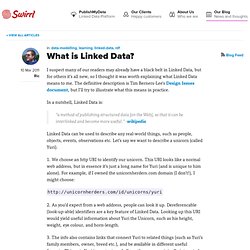

The two meanings of semantics in HTML5. There is a lot of confusion around HTML5 and RDFa, both in the Drupal community and outside of it. That’s why I decided to redevelop my site in Drupal 7 with HTML5 , using a base theme available on Drupal.org, to see for myself what it's like using HTML5 and RDFa together. HTML5 is the incontestable future of the Web, and it is becoming more and more clear that inline structured data is also going to be a fundamental part of the future Web... and, with the current core support for RDFa and the future core support for HTML5 , Drupal has an interest in both. The capabilities offered by HTML5—and the other standards that sometimes get conflated with it, such as CSS3—blow my mind. I’ve also been impressed by a number of the people involved in developing and evangelizing HTML5, particularly the emphasis I’ve seen on the social aspects of standards adoption/compliance and the concern for the cognitive load placed on the developer.
What more could you ask for? The trouble is the word semantics. Ravensburg Commerce Data on the Semantic Web: Information for Developers and Researchers. Overview Ravensburg is a town in the southern part of Germany with almost 1,000 years of history as a center of trade and business. In the Middle Ages, it was an Imperial Free City and its "Great Ravensburg Trading Society" (Große Ravensburger Handelsgesellschaft) owned shops and trading companies all over Europe (cf. Wikipedia). On April 14, 2011, Ravensburg became the first city in the world to publish an almost complete set of high-quality information about shops, tourist attractions, medical services, and many other points of interest using latest generation Semantic Web technology, namely the GoodRelations vocabulary for e-commerce, which was also invented in Ravensburg.
The Semantic Web, also known as the “Web 3.0”, is an extension of the current World Wide Web and will allow computers and smartphones to extract and recombine information from Web pages for much more intelligent on-line services. Relevance : The data is regularly updated. What is Linked Data? I suspect many of our readers may already have a black belt in Linked Data, but for others it’s all new, so I thought it was worth explaining what Linked Data means to me.

The definitive description is Tim Berners-Lee’s Design Issues document, but I’ll try to illustrate what this means in practice. In a nutshell, Linked Data is: “a method of publishing structured data [on the Web], so that it can be interlinked and become more useful.” -wikipedia Linked Data can be used to describe any real-world things, such as people, objects, events, observations etc. 1. 2. 3.
A Worked Example My description above hopefully sounds simple enough, but to clarify here’s a (more sensible) worked example… This is the URI that the folks at data.gov.uk have chosen to identify the City of Manchester local authority district: If you click on the link above, you will be redirected (via a 303 “see other” response) to an HTML page which contains information about the City of Manchester. DCMI Home: Dublin Core® Metadata Initiative (DCMI)
Linked Data: Evolving the Web into a Global Data Space. Riding the Semweb: the Toneelstof case. Surfing the Semantic Web.